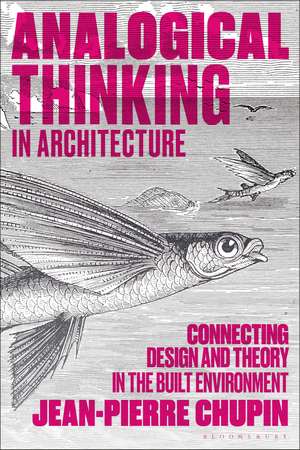Analogical Thinking in Architecture: Connecting Design and Theory in the Built Environment
Autor Dr Jean-Pierre Chupinen Limba Engleză Hardback – 23 aug 2023
Preț: 513.20 lei
Preț vechi: 732.84 lei
-30% Nou
Puncte Express: 770
Preț estimativ în valută:
98.20€ • 105.01$ • 81.88£
98.20€ • 105.01$ • 81.88£
Carte disponibilă
Livrare economică 27 martie-10 aprilie
Preluare comenzi: 021 569.72.76
Specificații
ISBN-13: 9781350343627
ISBN-10: 1350343625
Pagini: 256
Ilustrații: 173 bw illus
Dimensiuni: 156 x 234 x 17 mm
Greutate: 0.66 kg
Editura: Bloomsbury Publishing
Colecția Bloomsbury Visual Arts
Locul publicării:London, United Kingdom
ISBN-10: 1350343625
Pagini: 256
Ilustrații: 173 bw illus
Dimensiuni: 156 x 234 x 17 mm
Greutate: 0.66 kg
Editura: Bloomsbury Publishing
Colecția Bloomsbury Visual Arts
Locul publicării:London, United Kingdom
Caracteristici
The book is the first to situate Aldo Rossi's theory of the Città Analoga (Analogous City) within a larger framework of studies on analogical thinking
Notă biografică
Jean-Pierre Chupin is a professor at the Université de Montréal School of Architecture, where he holds the Canada Research Chair in Architecture, Competitions and Mediations of Excellence.
Cuprins
List of Analogical PlatesList of FiguresAcknowledgementsIntroduction: Analogy Beyond ResemblanceA Spectrum of DefinitionsA Canonical ExampleA Paucity of Theories for a Plethora of FactsDesign Process, Repertories, Cities and Theories1 Reflecting on Design ThinkingThe Design Process as an Object of ResearchCybernetic and Methodological AnaloguesAnalogy as Creative TechniqueToward a Cognitive Approach to DesignThe Rise of Design Thinking2 The Cyclical Case of Biological AnalogiesThe Intertwined Fates of Architecture and BiologyPeter Collins and the Biological AnalogyPhilip Steadman and the Evolutionary Design of Artefacts George Hersey and the Biological Roots of ArchitectureAnalogical Reasoning and the Burden of ProofLife Cycles of Biological Analogies3 In the Labyrinth of Analogous CitiesThe Città Analoga as a Visual EnigmaThe Critical Misfortune of a Hypothesis Climbing the Analogical MountainBack to Square One with Aldo Rossi4 From Linguistic Metaphors to Critical Analogies Classical Regimes of ResemblancePost-modern Metaphors of the ColumnCritiques of Linguistic AnalogyColin Rowe's Method of Analogical PairingConclusion: Connecting Design and Theory in the Built Environment The Analogical World of the ProjectAnalogy as Inclusive DeviceSnakes and LaddersDigital Analogues and Artificial ImaginationCognitive Leaps are the Order of ThingsBibliographyIndex
Recenzii
Analogical Thinking in Architecture is careful and timely study of analogy as a powerful tool for connecting design and theory in the built environment. Covering large grounds of theory and practice, Jean-Pierre Chupin makes a compelling argument about the potential of analogical thinking to renew the epistemological horizons of architectural theory and to contribute to a better understanding of contemporary design practice. Eloquently written and filled with insightful examples, it is a must-read for every architecture student, design educator and practitioner.
One of the foremost specialists of analogy, this fundamental dimension of architectural thinking, gives us an expanded English version of his seminal contribution to the study of a topic of interest both to theorists and practitioners. Indeed, analogy is key to the understanding of architectural creativity.
In four chapters, Jean-Pierre Chupin takes us on an intellectual and sensory journey, reviewing key moments in Western architectural theory and history and illuminating modes of thought that remain little explored in the discipline. Chupin argues persuasively that analogical thinking, in all its intellectual and poetic manifestations, needs to be further explored given the powerful capabilities it has always brought to the field. Building on the disciplinary and transdisciplinary strengths of architecture itself and across disciplines, Chupin foregrounds the specific modes of knowledge production in creative fields and offers this book as a first milestone on the road to "opening up a field of research that favors the creation of an architectural theory of projects understood as analog worlds." Analogical Thinking in Architecture is a must-read for scholars and practitioners alike.
One of the foremost specialists of analogy, this fundamental dimension of architectural thinking, gives us an expanded English version of his seminal contribution to the study of a topic of interest both to theorists and practitioners. Indeed, analogy is key to the understanding of architectural creativity.
In four chapters, Jean-Pierre Chupin takes us on an intellectual and sensory journey, reviewing key moments in Western architectural theory and history and illuminating modes of thought that remain little explored in the discipline. Chupin argues persuasively that analogical thinking, in all its intellectual and poetic manifestations, needs to be further explored given the powerful capabilities it has always brought to the field. Building on the disciplinary and transdisciplinary strengths of architecture itself and across disciplines, Chupin foregrounds the specific modes of knowledge production in creative fields and offers this book as a first milestone on the road to "opening up a field of research that favors the creation of an architectural theory of projects understood as analog worlds." Analogical Thinking in Architecture is a must-read for scholars and practitioners alike.
